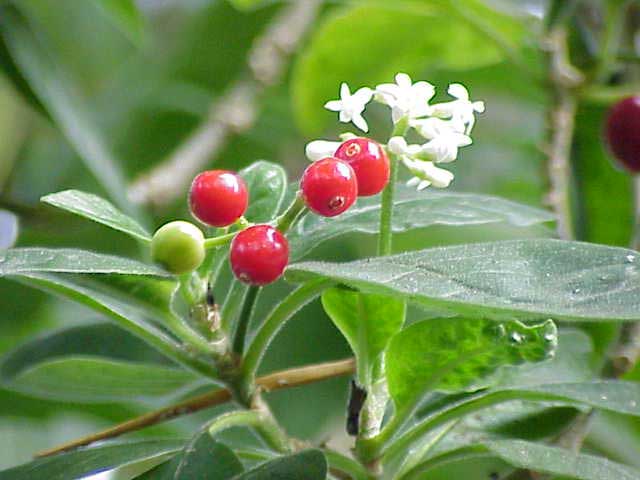
Carapichea ipecacuanha (*)
Classification System: APG IV
Superregnum: Eukaryota
Regnum: Plantae
Cladus: Angiosperms
Cladus: Eudicots
Cladus: Core eudicots
Cladus: Asterids
Cladus: Lamiids
Ordo: Gentianales
Familia: Rubiaceae
Subfamilia: Rubioideae
Tribus: Palicoureeae
Genus: Carapichea
Species: Carapichea ipecacuanha
Name
Carapichea ipecacuanha (Brot.) L.Andersson, Kew Bull. 57: 371 (2002)
Synonyms
Basionym
Callicocca ipecacuanha Brot., Mem. Sobre Ipecacuanha: 27 (1801)
Homotypic
Cephaelis ipecacuanha (Brot.) Willd., Berlin. Jahrb. Pharm. Verbundenen Wiss. 1804: 75 (1804)
Psychotria ipecacuanha (Brot.) Stokes, Bot. Mat. Med. 1: 365 (1812)
Ipecacuanha fusca Raf., Sylva Tellur.: 147 (1838)
Uragoga ipecacuanha (Brot.) Baill., Hist. Pl. 7: 370 (1880)
Evea ipecacuanha (Brot.) W.Wight, Contr. U.S. Natl. Herb. 9: 216 (1905)
Heterotypic
Ipecacuanha officinalis Arruda in H.Koster, Trav. Braz.: 497 (1816), nom. nud.
Ipecacuanha preta Arruda in H.Koster, Trav. Brazil: 497 (1816), not validly publ.
Uragoga granatensis Baill., Hist. Pl. 7: 370 (1880).
Cephaelis acuminata H.Karst., Deut. Fl.: 1196 (1883).
Uragoga acuminata (H.Karst.) Farw., Druggists' Circ. 61: 175 (1917), nom. illeg.
References
Andersson, L. 2002. Re-establishment of Carapichea (Rubiaceae, Psychotrieae). Kew Bulletin 57(2): 363-374. DOI: 10.2307/4111112
Govaerts, R. et al. 2018. Carapichea ipecacuanha in World Checklist of Selected Plant Families. The Board of Trustees of the Royal Botanic Gardens, Kew. Published on the internet. Accessed: 2018 Dec. 17. Reference page.
International Plant Names Index. 2018. Carapichea ipecacuanha. Published online. Accessed: DEc. 17 2018.
USDA, ARS, Germplasm Resources Information Network. Carapichea ipecacuanha in the Germplasm Resources Information Network (GRIN), U.S. Department of Agriculture Agricultural Research Service. Accessed: 08-Apr-12.
Vernacular names
беларуская: Іпекакуана
English: Ipecac
suomi: Oksetusjuuri
magyar: Ipekakuána
italiano: Ipecacuana
polski: Ipekakuana prawdziwa
Carapichea ipecacuanha is a species of flowering plant in the family Rubiaceae. It is native to Costa Rica, Nicaragua, Panama, Colombia, and Brazil. Its common name, ipecacuanha (Portuguese pronunciation: [ipe̞kɐkuˈɐ̃ɲɐ]), is derived from the Tupi ipega'kwãi, or "road-side sick-making plant". The plant has been discussed under a variety of synonyms over the years by various botanists. The roots were used to make syrup of ipecac, a powerful emetic, a longtime over the counter medicine no longer approved for medical use in the West, for lack of evidence of safety and efficacy. An example of emetic compound from the roots is emetine.[1]
Description
Ipecacuanha is a slow-growing plant, which reduces its commercial appeal as a crop plant. It is seldom cultivated in South America but it has been cultivated in India and elsewhere.[2]
The root of ipecacuanha has been used in preparation of the medicament, the syrup, is simple or divided into a few branches, flexuous, and composed of rings of various size. It is somewhat fleshy when fresh, and appearing as if closely strung on a central woody cord. The different kinds known in commerce (gray, red, brown) are all produced by the same plant, the differences arising from the age of the plant, the mode of drying, etc. Various other plants can be used as substitutes for it.
History
Ipecacuanha was known to Europe by the mid 17th century. Nicholas Culpeper, an English botanist, herbalist, and physician, compared Ipecacuanha to the herb Orach in his book, Complete Herbal & English Physician, published in 1653.[ One of the first recorded shipments of Ipecacuanha to Europe was in 1672, by a traveler named Legros, who imported a quantity of the root to Paris from South America.[3] In 1680, a Parisian merchant named Garnier possessed some 68 kilograms (150 pounds) of the substance and informed the physician Jean Claude Adrien Helvetius (1685–1755) of its power in the treatment of dysentery. Helvetius was granted sole right to vend the remedy by Louis XIV, but sold the secret to the French government, who made the formula public in 1688.[3]
Ipecacuanha has a long history of use as an emetic, for emptying the stomach in cases of poisoning, a use that has been discontinued in medical settings (see syrup of ipecac). It has also been used as a nauseant, expectorant, and diaphoretic, and was prescribed for conditions such as bronchitis. The most common and familiar preparation is syrup of ipecac, which was commonly recommended as an emergency treatment for accidental poisoning until the final years of the 20th century.[4] Ipecacuanha was also traditionally used to induce sweating. A common preparation for this purpose was Dover's powder.
In the 19th century, women prisoners at the Cascades Female Factory, Tasmania, were routinely given "a grain or so of ipecacuanha" as a precaution, especially "upon ladies with gross health and fiery temperaments."[5]
Chemical constituents
Ipecacuanha contains the alkaloids emetine (methylcephaeline) and cephaeline.[6] It also contains the pseudo-tannin ipecacuanhic acid or cephaëlic acid.[7][better source needed]
References
Emmanuel S. Akinboye, Oladapo Bakare; Biological Activities of Emetine, The Open Natural Products Journal, 2011, 4, pp. 8-15; doi:10.2174/1874848101104010008
Wapf, Victoria (2018-01-30). The Disease of Chopin. A comprehensive study of a lifelong suffering. ISBN 9785040211166.
Druett, Joan (2001). Rough Medicine: Surgeons at Sea in the Age of Sail. pp. 61–62. ISBN 9780415924528.
American Academy Of Pediatrics Committee On Injury, Violence (November 2003). "Policy statement: Poison treatment in the home". Pediatrics. 112 (5): 1182–1185. doi:10.1542/peds.112.5.1182. PMID 14595067.
Daniels, Kay. Convict Women. Allen & Unwin, 1998, p. 129.
Roberts, Margaret F.; Wink, Michael (1998). Alkaloids: biochemistry, ecology, and medicinal applications / edited by Margaret F. Roberts and Michael Wink. ISBN 0306454653.
"530. Ipecacuanha.—Ipecac. | Henriette's Herbal Homepage".
Retrieved from "http://en.wikipedia.org/"
All text is available under the terms of the GNU Free Documentation License

